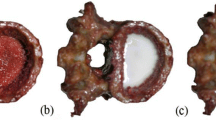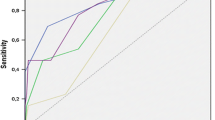Summary
We measured the lumbar bone mineral of 19 cadavers (10 women, 9 men) by dual photon absorptiometry (DPA) and quantitative computed tomography (QCT). In addition, we determined the ultimate load and stress of each vertebra, and finally ash content and volumetric ash density of the vertebral body. We found that single energy QCT was inferior to DPA and dual energy QCT in the prediction of the ultimate load or stress of vertebrae (P<0.001). The ultimate stress of predicted by using the dual energy QCT results (r=0.71; SEE=36.3 N/cm2) whereas the ultimate vertebral load was best predicted by using the DPA (BMC) results (r=0.80; SEE=740 N). If the QCT finding was multiplied with the surface area of the vertebral body it could be used to predict the ultimate load with good accuracy (r=0.74; SEE=841 N). All the above correlations were higher in women than in men. The frequency of vertebral compression fractures in the material was wel correlated with the bone mineral findings. A nonlinear (third degree) relationship between mineral content and mechanical characteristics is proposed but within the area of measurement used in clinical practice a linear (first degree) equation is preferred.
Similar content being viewed by others
References
Cann CE, Genant HK (1980) Precise measurement of vertebral mineral content using computed tomography. J Comput Assist Tomogr 4:493–500
Wahner HW, Dunn WL, Mazess RB, Towsley M, Lindsay R, Markhard L, Dempster D (1985) Dual photon Gd-153 absorptiometry of bone. Radiology 156:203–206
Bell GH, Dunbar O, Beck JS (1967) Variations in strength of vertebrae with age and their relation to osteoporosis. Calcif Tissue Res 1:75–86
Galante J, Rostocker W, Ray RD (1970) Physical properties of trabecular bone. Calcif Tissue Res 5:236–246
Dahlen N, Hellström L-G, Jacobsson B (1976) Bone mineral content and mechanical strength of the femoral neck. Acta Orthop Scand 47:503–508
Hansson T, Roos B, Nachemson A (1980) The bone mineral content and ultimate compressive strength of lumbar vertebrae spine 5:46–55
Brassow F, Crone-Münzebrock W, Weh L, Kranz R, Eggers-Stroeder G (1982) Correlations between breaking load and CT absorption values of vertebral bodies. Eur J Radiol 2:99–101
McBroom RJ, Hayes WC, Edwards WT, Goldberg RP, White AA (1985) Prediction of vetebral body compressive fracture using quantitative computed tomography. J Bone Jt Surg 67-A(8):1206–1214
Alvarez RE, Macovski A (1976) Energy-selective reconstructions in X-ray computerized tomography. Phys Med Biol 21:733–744
Eriksson S, Isberg B, Lindgren U (1988) Vertebral bone mineral measurement using dual-photon absorptiometry and computed tomography. Acta Radiol Scand 29:89–94
Brooks RA (1977) A quantitative theory of the Hounsfield unit and its application to dual energy scanning. J Comput Assist Tomogr 1:487–493
Eie N (1966) Load capacity of the low back. J Oslo City Hosp 4:75–98
Moroney M (1956) Facts from figures. A pelican book. Penguin Books Ltd, Hammondsworth, Middlesex, Great Britain, pp 295–296
Arvikar RJ, Seireg A (1978) Distribution of spinal disc pressures in the seated posture subjected to impact. Aviat Space Environ Med 49:166–169
Hirsch C, Nachemson A (1954) New observations on the mechanical behavior of lumbar discs. Acta Orthop Scand 23:254–283
Kazarian L, Graves G (1977) Compressive strength characteristics of the human vertebral centrum. Spine 2:1–14
Hansson T, Roos B (1981) The relation between bone mineral content, experimental compression fractures and disc degeneration in lumbar vertebrae. Spine 6:147–153
Perey O (1957) Fracture of the vertebral end-plate in the lumbar spine. Acta Orthop Scand (suppl) 25:1–89
Hartman W (1974) Deformation and failure of spinal materials. Experimental Mechanics 3:98–103
Rochoff SD, Sweet E, Bleustein J (1969) The relative contribution of trabecular and cortical bone to the strength of human lumbar vertebrae. Calcif Tissue Res 3:163–175
Buchanan JR, Myers C, Green RB, Lloyd T, Varano LA (1987) Assessment of vertebral fracture in menopausal women. J Bone Joint Surg 69-A:212–217
Riggs BL, Melton LJ (1986) Involutional osteoporosis. N Engl J Med 314:1676–1686
Cann CE, Genant HK, Kolb FO, Ettinger E (1985) Quantitative computed tomography for prediction of vertebral fracture risk. Bone 6:1–7
Author information
Authors and Affiliations
Rights and permissions
About this article
Cite this article
Eriksson, S.A.V., Isberg, B.O. & Lindgren, J.U. Prediction of vertebral strength by dual photon absorptiometry and quantitative computed tomography. Calcif Tissue Int 44, 243–250 (1989). https://doi.org/10.1007/BF02553758
Received:
Revised:
Issue Date:
DOI: https://doi.org/10.1007/BF02553758




